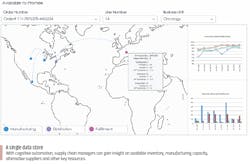Safety stock is among the most critical elements in the pharmaceutical supply chain. Yet safety stock has also proven very difficult to manage and optimize, even as it locks down working capital and drives up inventory costs.
Pharmaceutical companies typically maintain high levels of safety stock to achieve better service levels that maximize revenue of high-margin products and drive customer satisfaction. Also called buffer stock, it provides a safety net against variability such as unanticipated delays in raw materials or transportation, or unusually high demand.
Stockouts that result from inadequate safety stock could be highly damaging to the business, with millions in lost revenue and potential brand damage if vital medicines are unavailable. Erring on the side of excess is the prevailing practice, with safety stock in place at a company’s manufacturing plants and distribution centers around the world. But that also means erring on the side of high inventory costs and tying up working capital that could be invested in R&D or other areas of business growth.
It’s the Goldilocks challenge. Pharma companies can’t risk too little safety stock. But they don’t want the cost burden of too much. As in the children’s fable of Goldilocks and the Three Bears, pharma needs safety stock to be “just right.”
Rising risks in safety stock management
To meet the competing goals of minimizing safety stock costs and maximizing service levels, pharma supply chain planners have focused on tackling demand variability and lead time variability with a range of supply chain management software and spreadsheets. Those efforts are more challenging than ever in our hyper-speed digital age as new variables impacting safety stock keep popping up.
Increasing global complexity in the industry makes it more difficult to quickly and accurately predict market demand and lead times. Growth in real-time data from dozens or hundreds of applications overwhelms human efforts to manage and analyze information for data-driven decisions.
The result is best-guess planning when putting together a monthly demand forecast, and calculating lead times that account for materials availability, production schedules, demand variability, supplier reliability and other factors, all across a high number of SKU locations.
Due to this complexity, safety stock levels are usually based on a few variables, not a complete set. Supply chain planners are seldom willing to jeopardize service levels by cutting back safety stock. Maintaining a generous stock buffer is often regarded as a cost of doing business, but it doesn’t have to be.
Cognitive automation to recommend safety stocks
Cognitive automation is opening new opportunities to manage safety stock more cost-efficiently, by leveraging the use of artificial intelligence (AI) and machine learning. This emerging technology uses internet-scale compute power in the cloud, real-time data monitoring, cognition and sophisticated algorithms to bring new speed and precision to the pharmaceutical supply chain.
Pharma companies are among the leaders at embracing cognitive automation to refine demand forecasting and lead time calculations, setting the stage to optimize safety stock levels on a vast global scale. This technology brings intelligent supply chain automation of far greater scope and depth than is possible even with the most skilled planners and the best traditional tools.
As it is, planners can spend weeks collecting data from software applications for ERP, CRM, materials requirements planning, logistics, supplier and warehouse management, and others. Then, numbers are crunched for demand and lead calculations — but the information is outdated by the time forecasts are finalized, and it’s easy to overlook crucial variables.
Cognitive automation crawls multiple applications thousands of times a day, and aggregates and enriches data into a single data store. From there, powerful algorithms generate recommendations that can cover demand forecasts, lead time calculations and optimal safety stock levels. Several characteristics set AI-powered cognitive automation apart from traditional approaches:
Daily forecasting. Demand and lead times can be calculated on a daily basis because cognitive automation tracks data and anomalies in near real-time. That’s a vast improvement over manual forecasts once a month or other periodic intervals.
Deep granularity. Rather than summarized data, cognitive automation works with data sets of deep granularities, down to daily transactions by SKU locations, orders, plants, raw materials, customers and more.
End-to-end visibility. Cognitive automation brings to fruition the “Holy Grail” of end-to-end supply chain visibility, so that managers can evolve from reactive troubleshooting to proactive optimization and data-driven decision-making.
From a safety stock perspective, these capabilities can also help supply chain teams better manage time-sensitive expiring products to reduce inventory turns, shrinkage and the cost of needlessly discarded products.
Cognitive automation to mitigate drug stockout risks
In addition to providing more accurate safety stock, cognitive automation enables faster and better decisions to prevent drug stock outages. It increases supply chain agility and responsiveness.
Cognitive automation gathers, processes and analyzes in real-time very large volumes of data. Cognitive automation augments the human planner’s domain expertise, providing data-driven recommendations that they can execute on in real time.
Real-time recommendations. Based on the root cause and knowledge of other resources (e.g., available inventory, manufacturing capacity, alternative suppliers) cognitive automation predicts a drug stock outage and offers prescriptive suggestions to mitigate this risk.
Accelerate or automate decisions. Supply chain managers are able to make faster, more informed decisions to correct a problem before it cascades into a disaster. Or they may elect to have the cognitive automation system make decisions and take actions autonomously.
Safety stock has not gotten the attention it deserves, simply because it’s been so difficult to accurately forecast and because of the risk that under-stocking can pose to the business. Today, pharma companies have new opportunities to net substantial cost savings and free up working capital with an AI-powered approach to get safety stock “just right.”






